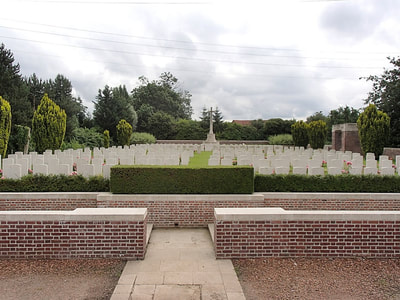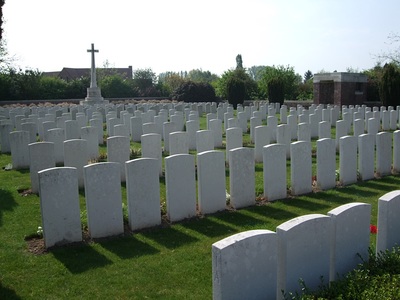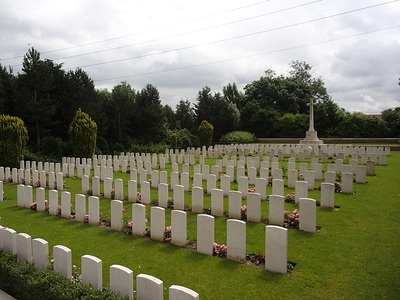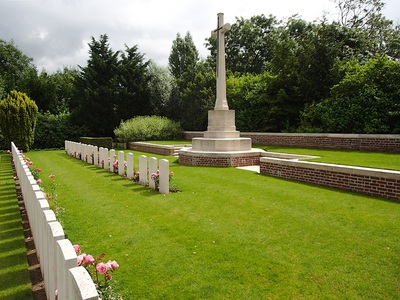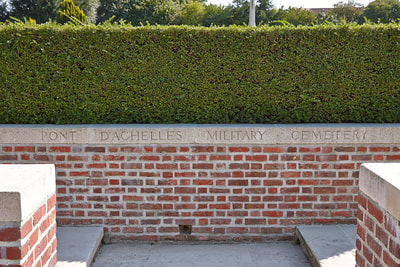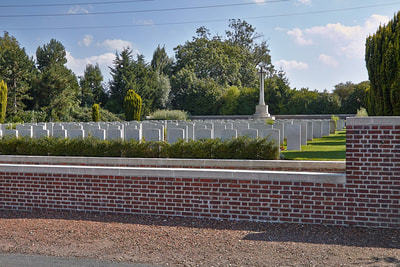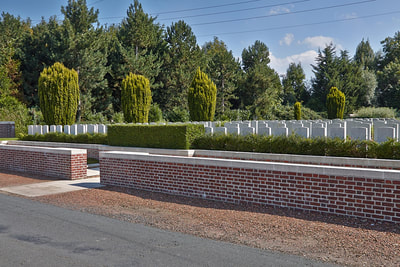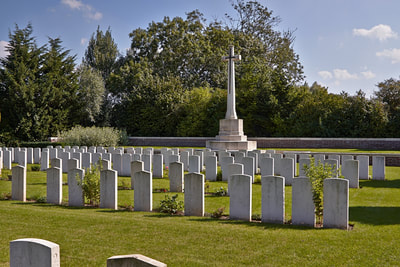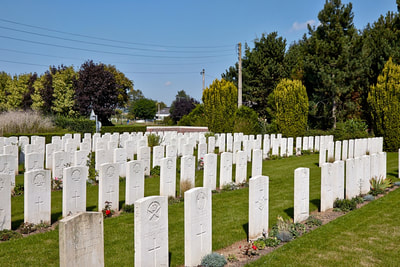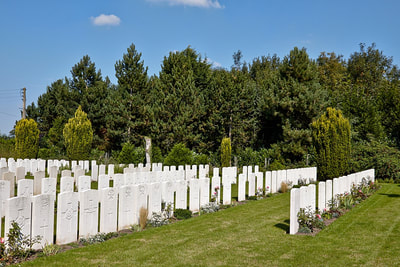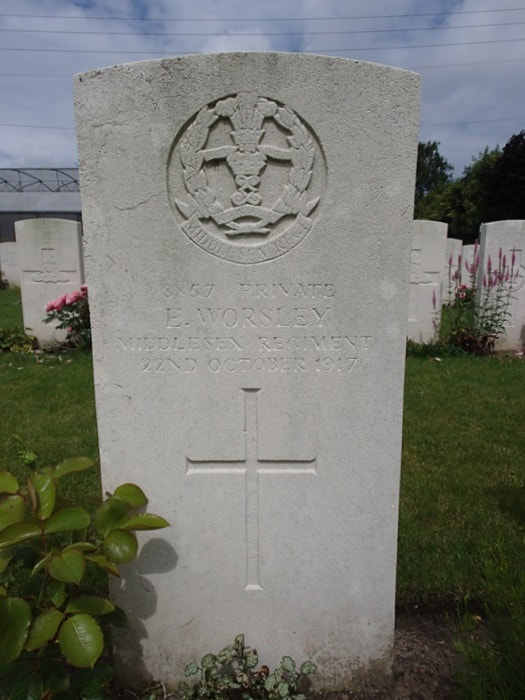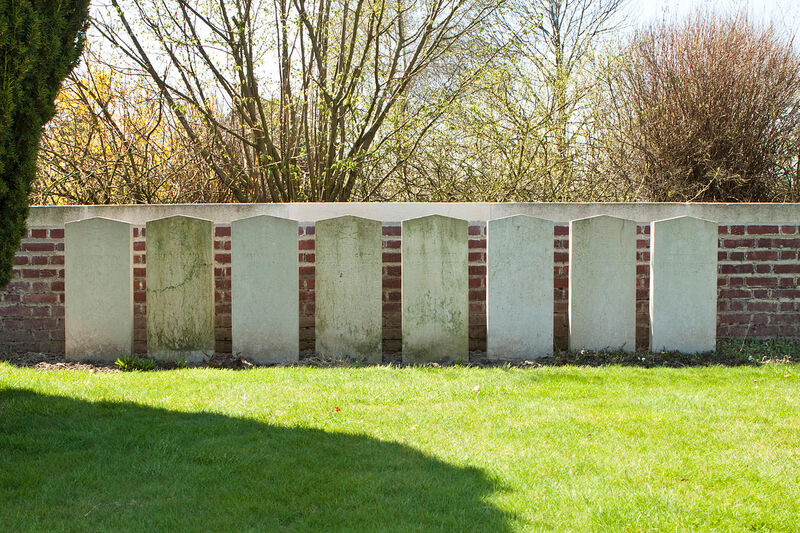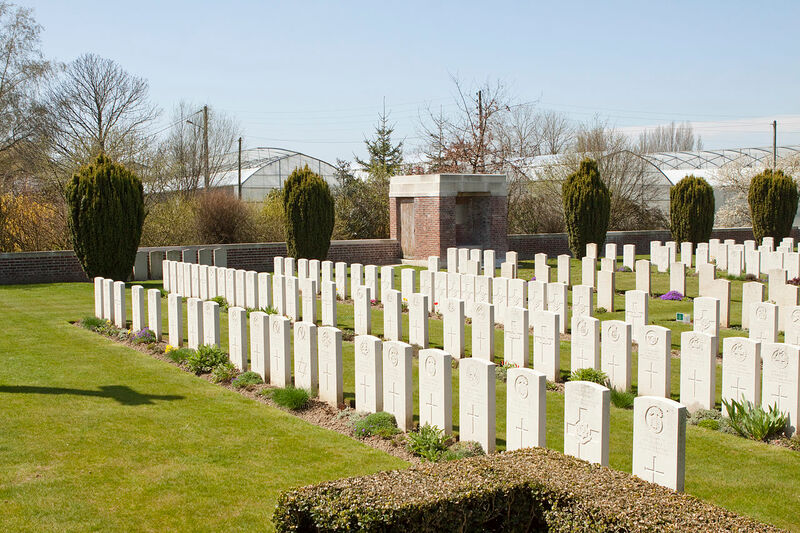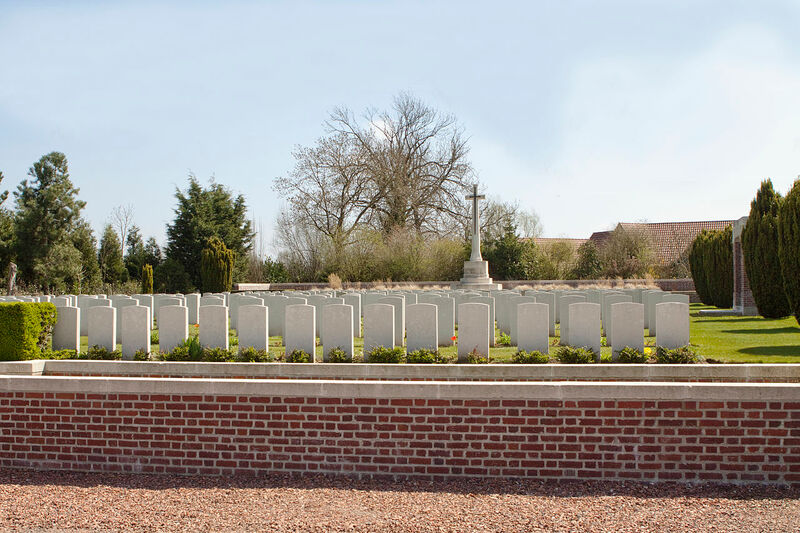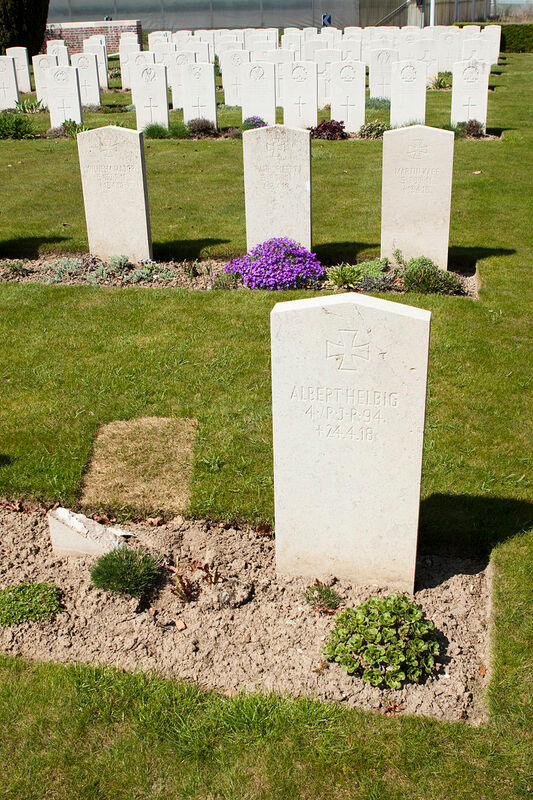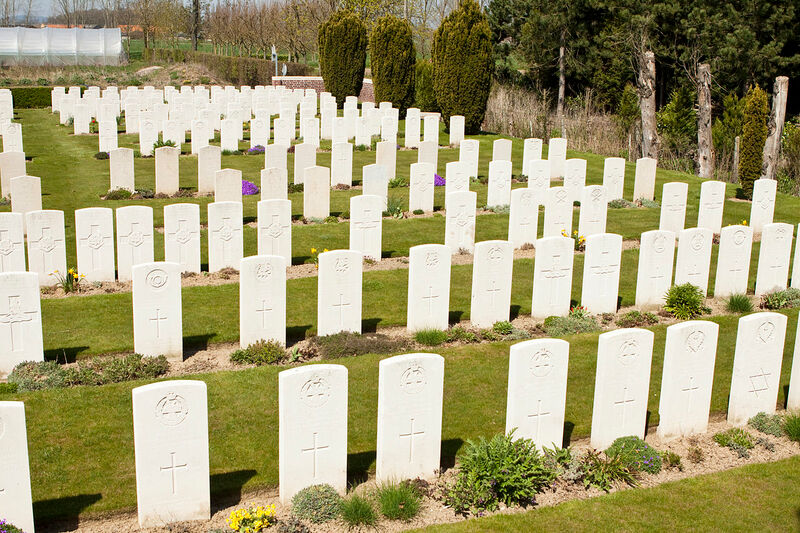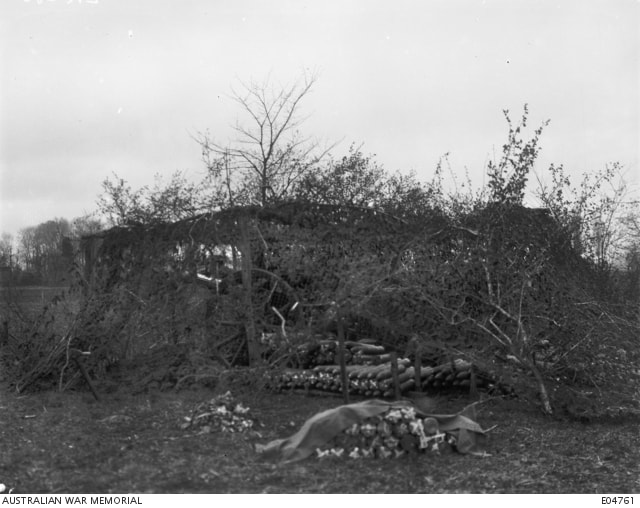PONT-D'ACHELLES MILITARY CEMETERY
Nieppe
Nord
France
Above image © Werner Van Caneghem
Location Information
The village of Nieppe is about 3.5 kilometres north-west of Armentieres on the road to Bailleul.
Leave Nieppe on the D933. 900 metres from the church turn right onto Rue du Sac. Pont-d'Achelles Military Cemetery is on the right hand side 200 metres from the main road.
Visiting Information
Wheelchair access is possible with some difficulty.
Historical Information
Pont-d'Achelles was within the Allied lines from 16 October 1914 until 11 April 1918, when the 34th Division were driven out of neighbouring Nieppe after hard fighting, which the Royal Newfoundland Regiment and the 1/2nd Monmouths continued for some hours at Pont-d'Achelles. Nieppe was recaptured by the 29th Division on 3 September 1918.
The military cemetery at Pont-d'Achelles was begun in June 1917 and used by field ambulances and fighting units until the German advance in the following April. It was used by the Germans during their occupation, under the name of Papot Military Cemetery, and it was resumed by the British in September and October 1918.
The cemetery contains 293 Commonwealth and 37 German burials of the First World War.
Casualty Details: UK 173, Australia 72, New Zealand 48, Germany 37, Total Burials: 330.
The cemetery was designed by Sir Herbert Baker
Dedications
6127 Private Lewis Edward Oliver, 23rd Coy. Australian Machine Gun Corps. 10th December 1917. Son of Edward John and Annie Gale Oliver of Northam, Western Australia
Never forgotten by your proud family back home, Leanne Maguire.
32067 Private J. R. Stonall, 11th Bn. East Lancashire Regiment, 12th September 1918.
May he be remembered always for his sacrifice to god and country, Brian Stonall
The village of Nieppe is about 3.5 kilometres north-west of Armentieres on the road to Bailleul.
Leave Nieppe on the D933. 900 metres from the church turn right onto Rue du Sac. Pont-d'Achelles Military Cemetery is on the right hand side 200 metres from the main road.
Visiting Information
Wheelchair access is possible with some difficulty.
Historical Information
Pont-d'Achelles was within the Allied lines from 16 October 1914 until 11 April 1918, when the 34th Division were driven out of neighbouring Nieppe after hard fighting, which the Royal Newfoundland Regiment and the 1/2nd Monmouths continued for some hours at Pont-d'Achelles. Nieppe was recaptured by the 29th Division on 3 September 1918.
The military cemetery at Pont-d'Achelles was begun in June 1917 and used by field ambulances and fighting units until the German advance in the following April. It was used by the Germans during their occupation, under the name of Papot Military Cemetery, and it was resumed by the British in September and October 1918.
The cemetery contains 293 Commonwealth and 37 German burials of the First World War.
Casualty Details: UK 173, Australia 72, New Zealand 48, Germany 37, Total Burials: 330.
The cemetery was designed by Sir Herbert Baker
Dedications
6127 Private Lewis Edward Oliver, 23rd Coy. Australian Machine Gun Corps. 10th December 1917. Son of Edward John and Annie Gale Oliver of Northam, Western Australia
Never forgotten by your proud family back home, Leanne Maguire.
32067 Private J. R. Stonall, 11th Bn. East Lancashire Regiment, 12th September 1918.
May he be remembered always for his sacrifice to god and country, Brian Stonall

5657 Private
Dene Edward Baker
43rd Bn. Australian Infantry, A. I. F.
9th June 1917, aged 24.
Plot II. A. 8.
Son of Edwin Herbert and Rosina Baker. Native of Yorke Town, South Australia.
From Yorketown, South Australia. A 23 year old labourer prior to enlisting on 8 April 1916, he embarked for overseas with the 18th Reinforcements of the 10th Battalion from Adelaide on 27 June 1916 aboard HMAT Barambah. Following further training in England, he transferred to the 43rd Battalion and went with them to France and then to Belgium. Pte Baker died of wounds on 9 June 1917.
At Ploegsteert Wood, Belgium, Dene Baker was hit by a shell which blew his legs off, he insisted that he be left and that others who were injured were treated. He was taken to the Dressing Station at Pont-D'Achelles where he died of his wounds.
Dene Edward Baker
43rd Bn. Australian Infantry, A. I. F.
9th June 1917, aged 24.
Plot II. A. 8.
Son of Edwin Herbert and Rosina Baker. Native of Yorke Town, South Australia.
From Yorketown, South Australia. A 23 year old labourer prior to enlisting on 8 April 1916, he embarked for overseas with the 18th Reinforcements of the 10th Battalion from Adelaide on 27 June 1916 aboard HMAT Barambah. Following further training in England, he transferred to the 43rd Battalion and went with them to France and then to Belgium. Pte Baker died of wounds on 9 June 1917.
At Ploegsteert Wood, Belgium, Dene Baker was hit by a shell which blew his legs off, he insisted that he be left and that others who were injured were treated. He was taken to the Dressing Station at Pont-D'Achelles where he died of his wounds.
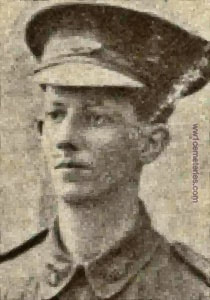
3034 Private
James Raymond Baldey
23rd Coy. Australian Machine Gun Corps
13th December 1917, aged 25.
Plot II. F. 2.
Son of James Edward and Louisa Baldey. Native of Tenterfield, New South Wales.
James Baldey was in the subsidiary line at Ploegsteert Wood, making tea, when he was hit by a 'Whizz Bang' and killed instantly. His body was later carried out and buried at Pont-D'Achelles.
James Raymond Baldey
23rd Coy. Australian Machine Gun Corps
13th December 1917, aged 25.
Plot II. F. 2.
Son of James Edward and Louisa Baldey. Native of Tenterfield, New South Wales.
James Baldey was in the subsidiary line at Ploegsteert Wood, making tea, when he was hit by a 'Whizz Bang' and killed instantly. His body was later carried out and buried at Pont-D'Achelles.
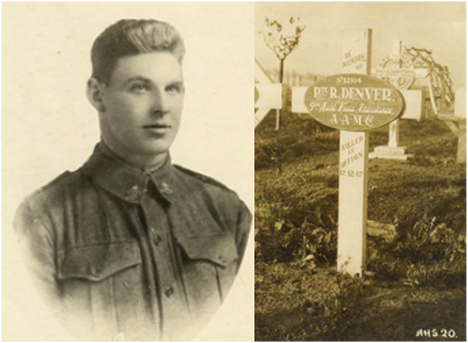
12104 Private
Ralph Denver
9th Field Ambulance. Australian Army Medical Corps.
12th December 1917, aged 22.
Plot II. F. 3.
Son of Edward and Annie Denver, of 606, Harris St., Ultimo, New South Wales. Native of Narrandera, New South Wales.
His headstone bears the inscription; "He Was A True Born Australian Son And For His Country Nobly Died."
Below are the first memorials from the Sydney Morning Herald in 1918 on the one year anniversary of his death.
Killed by a bomb dropped from an enemy aeroplane while on his way to a football match.
DENVER.- "In loving memory of our dear only son, Ralph, aged 22 years, killed In action in France, December 12, 1917. late 9th Field Ambulance."
"When the war is over
And the heroes all come home. Have pity on the watching ones
Whose dear one will ne'er come home."
Inserted by his loving father and mother, Edward and Annie Denver, only sister, Hilda, and cousin Ruth.
DENVER.- "In memory of our darling nephew, Ralph, aged 22 years, killed in action. France, December 12, 1917. Inserted by his loving aunties. Mary, May, and Lill."
Ralph Denver
9th Field Ambulance. Australian Army Medical Corps.
12th December 1917, aged 22.
Plot II. F. 3.
Son of Edward and Annie Denver, of 606, Harris St., Ultimo, New South Wales. Native of Narrandera, New South Wales.
His headstone bears the inscription; "He Was A True Born Australian Son And For His Country Nobly Died."
Below are the first memorials from the Sydney Morning Herald in 1918 on the one year anniversary of his death.
Killed by a bomb dropped from an enemy aeroplane while on his way to a football match.
DENVER.- "In loving memory of our dear only son, Ralph, aged 22 years, killed In action in France, December 12, 1917. late 9th Field Ambulance."
"When the war is over
And the heroes all come home. Have pity on the watching ones
Whose dear one will ne'er come home."
Inserted by his loving father and mother, Edward and Annie Denver, only sister, Hilda, and cousin Ruth.
DENVER.- "In memory of our darling nephew, Ralph, aged 22 years, killed in action. France, December 12, 1917. Inserted by his loving aunties. Mary, May, and Lill."
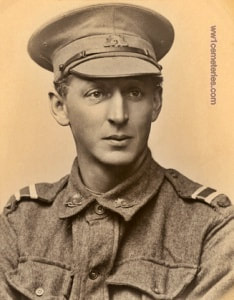
2302 Private
George Fleming
36th Bn. Australian Infantry, A. I. F.
8th June 1917.
Plot II. A. 17.
Pte Fleming fought with his unit at the Battle of Messines, where he was struck in the head by a piece of shrapnel on 7 June 1917. He died at a nearby dressing station the following day
George Fleming
36th Bn. Australian Infantry, A. I. F.
8th June 1917.
Plot II. A. 17.
Pte Fleming fought with his unit at the Battle of Messines, where he was struck in the head by a piece of shrapnel on 7 June 1917. He died at a nearby dressing station the following day
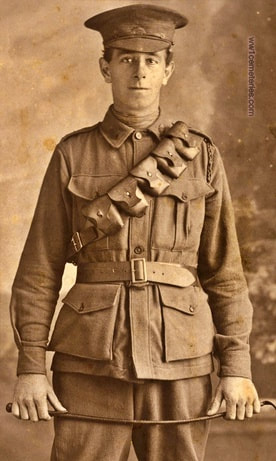
344 Private
Wilfred Owen Gibbons
42nd Bn. Australian Infantry, A. I. F.
1st June 1917, aged 29.
Plot I. A. 15.
Son of Richard Henry and Blanche C. Gibbons, of "Hazel Dell," Powell St., Coogee, New South Wales. Native of Northwood, England.
Originally from Handley, England, Pte Gibbons was a station hand from Longreach, Queensland prior to enlistment and embarked with B Company from Sydney on HMAT Borda on 5 June 1916. Later wounded in action in Belgium, he succumbed to his wounds on 1 June 1917, aged 29.
Wilfred Gibbons was in the trenches at Ploegsteert Wood when he received wounds to his head from an exploding shell. He was taken to a Dressing Station where he died of his wounds.
Wilfred Owen Gibbons
42nd Bn. Australian Infantry, A. I. F.
1st June 1917, aged 29.
Plot I. A. 15.
Son of Richard Henry and Blanche C. Gibbons, of "Hazel Dell," Powell St., Coogee, New South Wales. Native of Northwood, England.
Originally from Handley, England, Pte Gibbons was a station hand from Longreach, Queensland prior to enlistment and embarked with B Company from Sydney on HMAT Borda on 5 June 1916. Later wounded in action in Belgium, he succumbed to his wounds on 1 June 1917, aged 29.
Wilfred Gibbons was in the trenches at Ploegsteert Wood when he received wounds to his head from an exploding shell. He was taken to a Dressing Station where he died of his wounds.
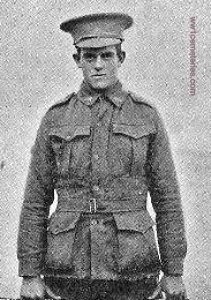
428 Private
Gordon Henry Jago
40th Bn. Australian Infantry, A. I. F.
7th June 1917, aged 21.
Plot I. B. 10.
Son of Fred and the late Mary Jago, of Exton, Tasmania. Native of Deloraine, Tasmania.
His headstone bears the inscription; "Deeply Mourned."
Gordon Henry Jago
40th Bn. Australian Infantry, A. I. F.
7th June 1917, aged 21.
Plot I. B. 10.
Son of Fred and the late Mary Jago, of Exton, Tasmania. Native of Deloraine, Tasmania.
His headstone bears the inscription; "Deeply Mourned."
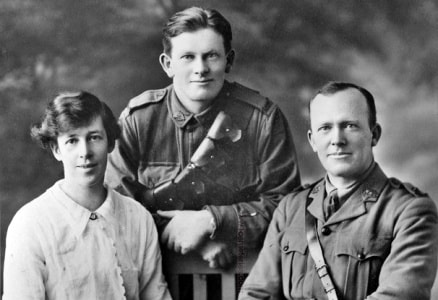
2743A Sapper
Noel Alaric Lahey (Centre)
11th Field Coy. Australian Engineers
10th June 1917, aged 25.
Plot II. A. 5.
Noel Alaric Lahey (Centre)
11th Field Coy. Australian Engineers
10th June 1917, aged 25.
Plot II. A. 5.
The artist Frances Vida Lahey and two of her brothers: 2743A Sapper (Spr) Noel Alaric Lahey, 9th Battalion (centre), and 2nd Lieutenant (2Lt) Romeo Watkins Lahey, 3rd Divisional Engineers. Vida, the eldest of twelve siblings, moved from the family home in Corinda, Qld, to London in July 1915 to provide a home base for her brothers and cousins serving in the AIF. Soon after arriving she became involved in voluntary war work tracing aeroplane parts, working at the Anzac buffet, taking servicemen on convalescent leave on outings, and other activities with the Red Cross Society. Spr Noel Lahey served in France with the 9th Battalion until June 1916, when he received a gunshot wound to the right arm and was evacuated to hospitals in Boulogne and England. He later transferred to the 11th Field Company Australian Engineers (part of the 3rd Divisional Engineers) to be with his brother Romeo. On 9 June 1917 Spr Lahey was wounded in action at Ploegsteert Wood, Belgium. Suffering from multiple gunshot wounds, he was admitted to the 9th Australian Field Ambulance, where his brother Romeo visited him. The following day he died from his wounds, aged 25 years. 2Lt Romeo served in France with the 3rd Divisional Engineers, and was promoted to Lieutenant in January 1917. He fought at Zonnebeke, Passchendaele, the Somme, Villers Bretonneux and in the final advance to the Hindenburg Line. In August 1918 he was briefly seconded as assistant staff captain to the 11th Infantry Brigade headquarters. After the war, whilst waiting to be repatriated, Lt Romeo Lahey attended a town planning course at the University of London's School of Architecture, and won the prestigious Lever Prize for his redesign of a war damaged approach road from Charing Cross to Euston station. He returned to Australia in May 1919. Several years after the war, Vida recorded the Armistice Day celebrations she had witnessed in London on 11 November 1918 in the painting 'Rejoicing and Remembrance',
Images in this gallery © Geerhard Joos
Shot at Dawn
Private Ernest Worsley, 2nd Bn. Middlesex Regiment, executed for desertion 22nd October 1917. Plot 1. F. 3. A volunteer who had enlisted in 1914 & served in France since July 1915, he ran off in the autumn of 1917 when sent out of the front line trenches to draw rations. Worsley was arrested in Calais 6 days later — without his equipment. (Putkowski,pp.207-208)
Private Ernest Worsley, 2nd Bn. Middlesex Regiment, executed for desertion 22nd October 1917. Plot 1. F. 3. A volunteer who had enlisted in 1914 & served in France since July 1915, he ran off in the autumn of 1917 when sent out of the front line trenches to draw rations. Worsley was arrested in Calais 6 days later — without his equipment. (Putkowski,pp.207-208)


